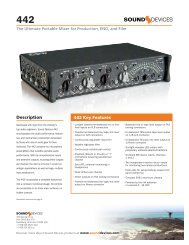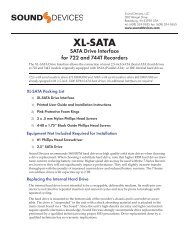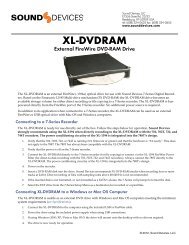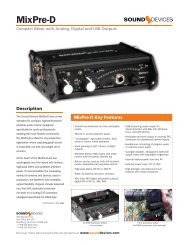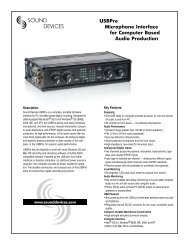MP-1 Packing List - Sound Devices, LLC
MP-1 Packing List - Sound Devices, LLC
MP-1 Packing List - Sound Devices, LLC
Create successful ePaper yourself
Turn your PDF publications into a flip-book with our unique Google optimized e-Paper software.
Operational Notes<br />
Transformers<br />
The isolation characteristics of transformers are superior to other balancing techniques for the adverse<br />
and uncontrolled environments of field production. Transformers provide complete galvanic isolation<br />
from the driving source, meaning there is no direct electrical connection. Signals are “transformed”<br />
magnetically. Both the transformers in the <strong>MP</strong>-1 use premium magnetic core material to achieve high<br />
signal handling capability (especially at low frequencies) while keeping distortion to a minimum. Because<br />
of their inherently high common mode impedance, transformers are unrivaled by any other type<br />
of input for common-mode noise rejection.<br />
Both the input and output of the <strong>MP</strong>-1 can be balanced or unbalanced without any problems. When unbalancing<br />
(either input or output) ground pin-3 to pin-1. There is no change in gain with an unbalanced<br />
connection into or out of the <strong>MP</strong>-1.<br />
Phantom Power<br />
Microphones that require phantom power should use the lowest voltage acceptable to maximize battery<br />
life. Electret-condenser microphones that can operate on phantom voltages from 11–52 volts will not<br />
have any performance benefit using 48-volt phantom; therefore 12-volt phantom is appropriate. Microphones<br />
requiring 48-volt phantom will not operate, or may operate with lower headroom and increased<br />
distortion, at 12 volts, therefore use 48-volt phantom. Consult your microphone documentation.<br />
Dynamic microphones typically do not require phantom power. A properly connected balanced, dynamic<br />
microphone will, typically, not be affected by the presence of phantom power nor will it draw<br />
any current. However, it is good practice to turn phantom power off if the microphone cable is suspect.<br />
Poor or incorrectly wired microphone cable can cause audible artifacts in the microphone signal. (Phantom<br />
is an excellent cable tester.)<br />
High-Pass Filter<br />
The two positions of the high pass filter (low cut) in the <strong>MP</strong>-1 are useful for removing excess low frequency<br />
energy in the audio signal. The 80 Hz position is appropriate when recording general speech,<br />
music, and ambient sound. The 160 Hz position is useful to enhance speech clarity. The high pass filter<br />
is a single pole design, 6 dB per octave.<br />
When possible, attempt to equalize at the sound source with microphone selection, use of a windscreen,<br />
microphone placement, and onboard microphone filtering. A high pass filter on the microphone and a<br />
high pass filter on the <strong>MP</strong>-1 will give an additive effect, increasing the slope of the filter.<br />
Limiter<br />
The <strong>MP</strong>-1 has a built in peak responding limiter which can be turned on or off by the switch on the front<br />
panel. The <strong>MP</strong>-1 limiter is really two completely separate limiters activated by the one switch; the first<br />
limiter keeps the input gain stage from clipping, and the second limiter limits the output to +17 dBu.<br />
The two limiters enable the <strong>MP</strong>-1 to limit in excess of 50 dB, meaning that it is very difficult to clip the<br />
unit, no matter the gain setting. The Limiter LED on the front panel illuminates in proportion to the<br />
amount of limiting.<br />
page 7







